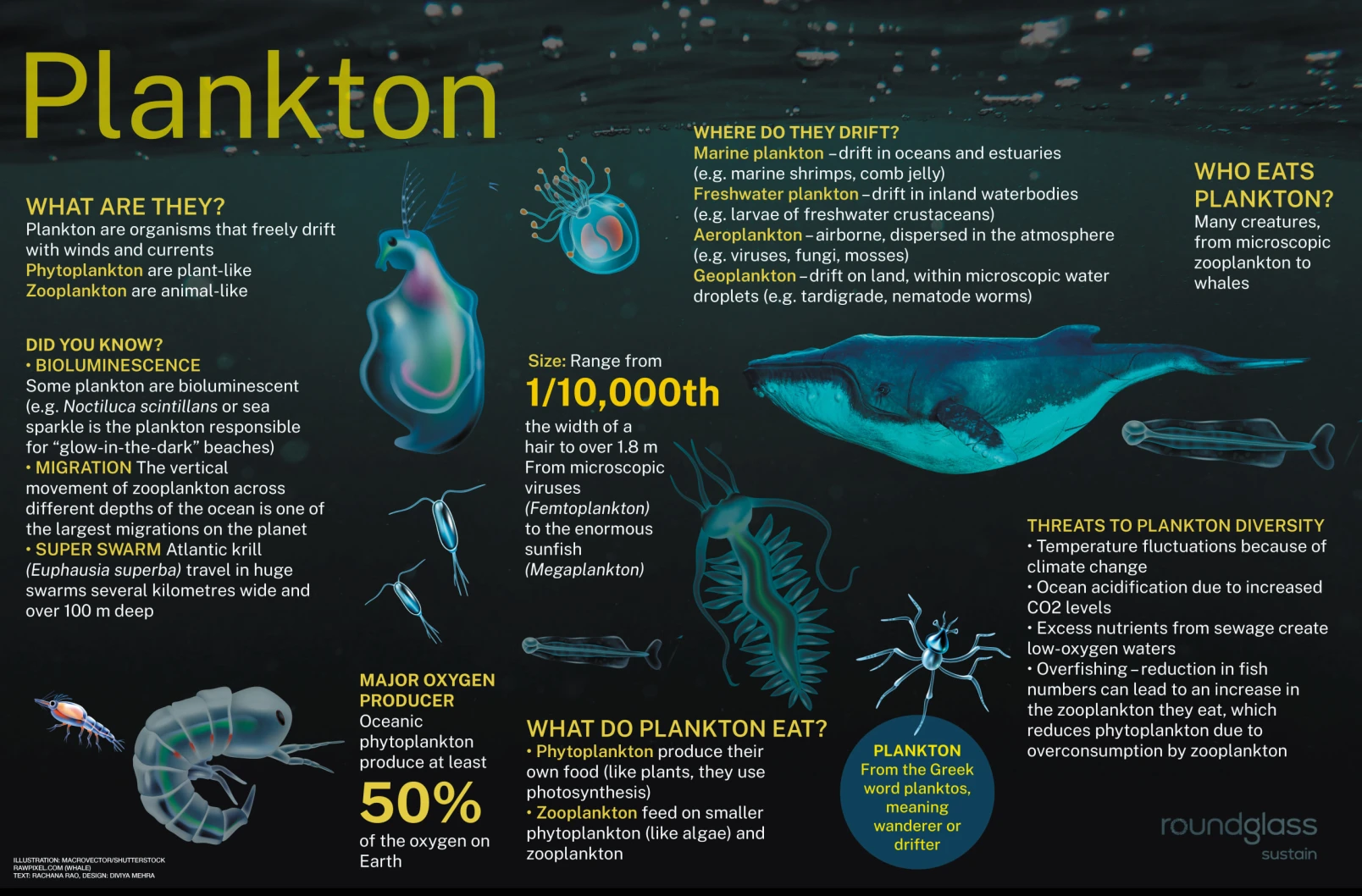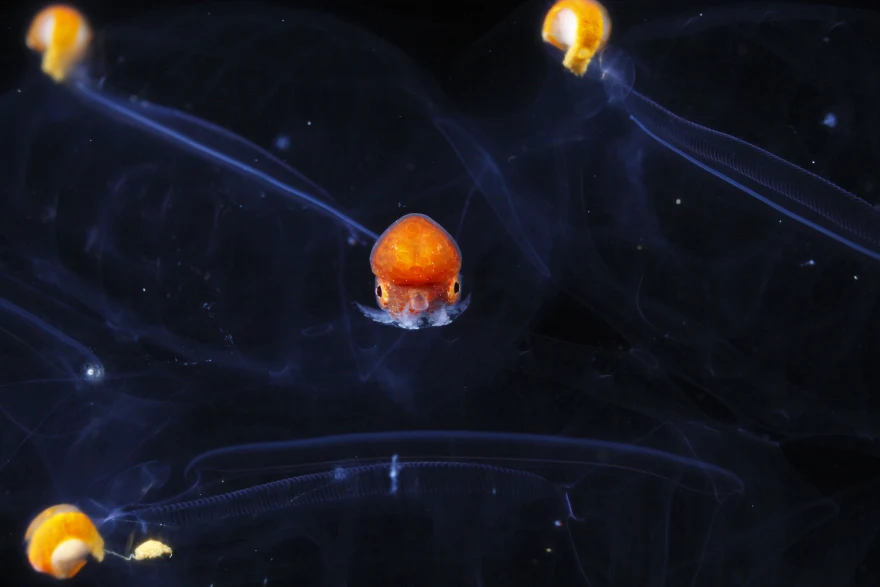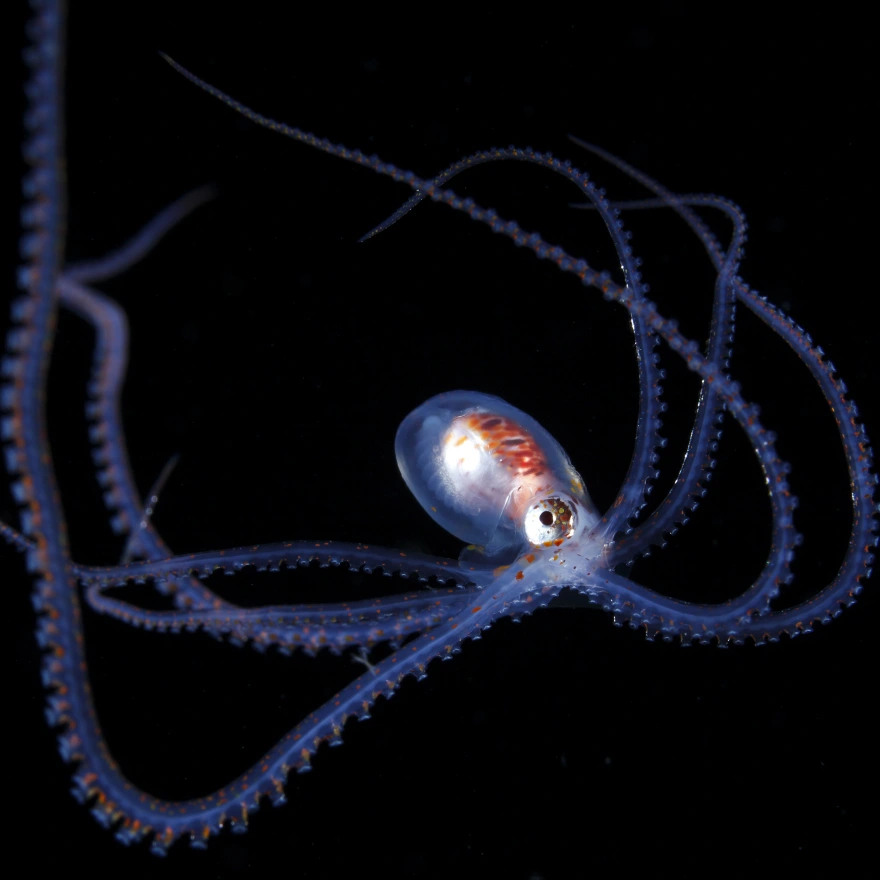All About Plankton
Plankton, a term derived from the Greek word “plankton,” meaning “wanderer” or “drifter,” encompasses an array of organisms that range from bacteria to tiny algae and small animals. Their significance in marine ecosystems cannot be overstated, as they form the foundational trophic level, supporting the intricate food web that sustains aquatic life. In particular, phytoplankton, the plant-like members of the planktonic community, are of profound importance due to their ability to harness sunlight through photosynthesis, converting it into energy and oxygen. https://naturefins.com/do-plankton-photosynthesize/

Plankton are the diverse collection of organisms that drift in water (or air) but are unable to actively propel themselves against currents (or wind).
Marine plankton include bacteria, archaea, algae, protozoa, microscopic fungi, and drifting or floating animals that inhabit the saltwater of oceans and the brackish waters of estuaries. Freshwater plankton are similar to marine plankton, but are found in lakes and rivers. Mostly, plankton just drift where currents take them, though some, like jellyfish, swim slowly but not fast enough to generally overcome the influence of currents.
Although plankton are usually thought of as inhabiting water, there are also airborne versions that live part of their lives drifting in the atmosphere. These aeroplankton include plant spores, pollen and wind-scattered seeds. They may also include microorganisms swept into the air from terrestrial dust storms and oceanic plankton swept into the air by sea spray.
Though many planktonic species are microscopic in size, plankton includes organisms over a wide range of sizes, including large organisms such as jellyfish. This is because plankton are defined by their ecological niche and level of motility rather than by any phylogenetic or taxonomic classification. The “plankton” category differentiates these organisms from those that float on the water’s surface, called neuston, those that can swim against a current, called nekton, and those that live on the deep sea floor, called benthos.

(An octopus larva surrounded by various types of salpa (translucent, floating animals found in warm water)

(A larval long arm octopus)

(Larva of a sipunculid worm. Adults are long, slender, and live on the ocean floor) https://www.nbcnews.com/slideshow/stunning-underwater-photos-explore-secret-life-plankton-n769321
Plankton are divided into 5 broad functional groups:
Phytoplankton (from Greek phyton, or plant) are autotrophic prokaryotic or eukaryotic algae that live near the water surface where there is sufficient light to support photosynthesis. Among the more important groups are the diatoms, cyanobacteria, dinoflagellates, and coccolithophores.
Zooplankton (from Greek zoon, or animal) are small protozoans or metazoans (e.g. crustaceans and other animals) that feed on other plankton. Some of the eggs and larvae of larger nektonic animals, such as fish, crustaceans, and annelids, are included here.
Mycoplankton include fungi and fungus-like organisms, which, like bacterioplankton, are also significant in remineralisation and nutrient cycling.
Bacterioplankton include bacteria and archaea, which play an important role in remineralising organic material down the water column (note that prokaryotic phytoplankton are also bacterioplankton).
Virioplankton are viruses. Viruses are more abundant in the plankton than bacteria and archaea, though much smaller.
Many of these types of plankton are mixotrophs or mixoplankton- which means they are organisms that act as both producers and consumers, either at the same time or switching between modes of nutrition in response to ambient conditions. This makes it possible to use photosynthesis for growth when nutrients and light are abundant, but switch to eating phytoplankton, zooplankton or each other when growing conditions are poor. Mixotrophs are divided into two groups; constitutive mixotrophs (CMs) which are able to perform photosynthesis on their own, and non-constitutive mixotrophs (NCMs) which use phagocytosis to engulf phototrophic prey that are either kept alive inside the host cell, which benefits from its photosynthesis, or they digested, except for the plastids, which continue to perform photosynthesis (kleptoplasty).
Recognition of the importance of mixotrophy as an ecological strategy is increasing, as well as the wider role this may play in marine biogeochemistry. Studies have shown that mixotrophs are much more important for marine ecology than previously assumed and comprise more than half of all microscopic plankton. Their presence acts as a buffer that prevents the collapse of ecosystems during times with little to no light. https://en.wikipedia.org/wiki/Plankton

Algae and Phytoplankton
Phytoplankton are a type of algae.
Algae is an informal term for any organisms of a large and diverse group of photosynthetic eukaryotes, which include species from multiple distinct clades. Such organisms range from unicellular microalgae such as Chlorella, Prototheca and the diatoms, to multicellular macroalgae such as the giant kelp, a large brown alga which may grow up to 50 metres (160 ft) in length. Most algae are aquatic organisms and lack many of the distinct cell and tissue types, such as stomata, xylem, and phloem that are found in land plants. The largest and most complex marine algae are called seaweeds. In contrast, the most complex freshwater forms are the Charophyta, a division of green algae which includes, for example, Spirogyra and stoneworts. Algae that are carried passively by water are plankton, specifically phytoplankton. https://en.wikipedia.org/wiki/Algae

Plankton live in both salt and freshwater. Some plankton are bacteria, some are protists (primarily unicellular organisms defined as any eukaryote that is not an animal, plant, or a fungus); but many plankton are actually single-celled plants. They are called “phytoplankton.”
Marine sea algae is a type of phytoplankton. They use photosynthesis to make food, just like large plants. This is a springtime phytoplankton bloom in the Bay of Biscay, off the coast of France. Phytoplankton are the base of the ocean’s food pyramid as well as one of our main sources of oxygen. https://earthobservatory.nasa.gov/images/81102/swirls-in-the-waters-off-france
Scientists estimate that 50% to 80% of the world’s oxygen is produced by phytoplankton.
Zooplankton are the animal type of plankton. They don’t use photosynthesis like phytoplankton. They actually eat plants or other tiny animals.
Krill is one of the most famous types of zooplankton (animal plankton) because baleen whales survive off krill. Krill is at the base of the ocean’s food chain, with an estimated biomass of around 379,000,000 metric tons.
(source)
Many whales, seals, penguins, squid, and fish survive on krill. Krill are also the main prey of baleen whales, including the blue whale (the largest animal that’s ever lived on earth.) This is a rare video of blue whale feeding on krill. Krill are overfished by humans and bans must be enacted to allow their populations to properly thrive.
Plankton and Bioluminescence
Many different kinds of plankton are bioluminescent (they glow at night). Bioluminescence is the production and emission of light by a living organism.
While some algae blooms that glow are ecologically beneficial, some are harmful like the Noctiluca scintillans, seen in the image above.
Toxic Algae Blooms
Harmful algae blooms produce toxins in the water that poison marine life and decimate “good” plankton populations. Human illnesses are caused by harmful algae blooms, which can be debilitating or even fatal. Shellfish in harmful algae blooms can be toxic and unsafe to eat. Pollution and climate change are the main factor causing these harmful algae blooms. https://scripps.ucsd.edu/labs/mlatz/bioluminescence/dinoflagellates-and-red-tides/
There are also a type of harmful organism known as blue-green algae; these are a type of bacteria, specifically cyanobacteria. Cyanobacteria are a group of autotrophic gram-negative bacteria of the phylum Cyanobacteriota that can obtain biological energy via oxygenic photosynthesis. The name “cyanobacteria” comes from Ancient Greek κύανος (kúanos) ‘blue’), referring to their bluish green (cyan) color. Cyanobacteria’s informal common name, blue-green algae, is technically inaccurate because as prokaryotes, they are not scientifically classified as algae. https://en.wikipedia.org/wiki/Cyanobacteria
Blue-green algae has now been proven to cause ALS (Lou Gehrig’s disease) https://imgur.com/gallery/ldoV2VO
Blue-green algae includes the species chlorella and spirulina- organisms that research is showing are toxic yet are still marketed as health supplements. Many doctors are now advising not to consume them: https://www.drweil.com/diet-nutrition/food-safety/is-spirulina-safe/
Note: Eating certain seaweeds is safe, as they are not cyanobacteria. Seaweeds are large, macroscopic marine algae, like kelp or sea lettuce, while blue-green algae (cyanobacteria) are microscopic bacteria that can form blooms in freshwater and saltwater. Seaweeds are photosynthetic organisms with cells containing chloroplasts, while blue-green algae are prokaryotes lacking membrane-bound organelles and therefore don’t have chloroplasts.
Red Tides
Many harmful algae blooms appear as red tides in the daytime (not all of them though). Some of these types of algae blooms are caused by the protist kind of plankton, specifically a group of species called dinoflagellates. http://climateandlife.columbia.edu/2017/12/04/studying-bioluminescent-blooms-in-the-arabian-sea/
The term “red tide” is actually being phased out and being replaced with the term “harmful algae bloom” because some harmful algae blooms appear as brown rather than red or, have no color at all.
While some beneficial plankton are sturgglingin the face of climate chaneg, there is much hope. Humanity is in the beginning stages of switching to solar power and electric vehicles (including ships). The earth’s temperature will cool off and stabilize, the oceans will be healthy and clean again, and the plankton will thrive.
